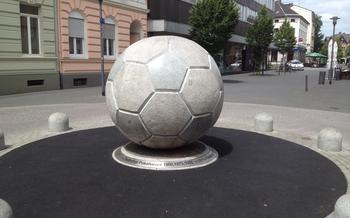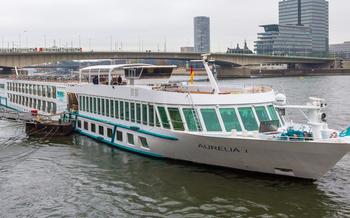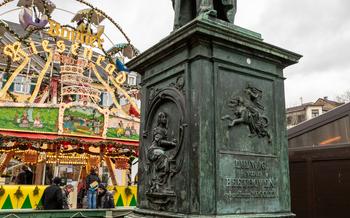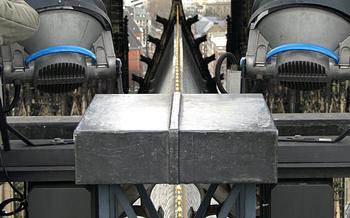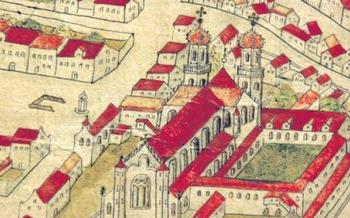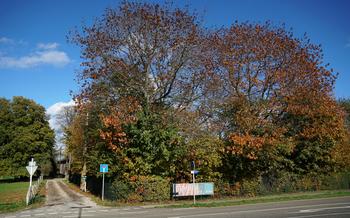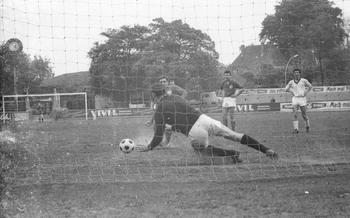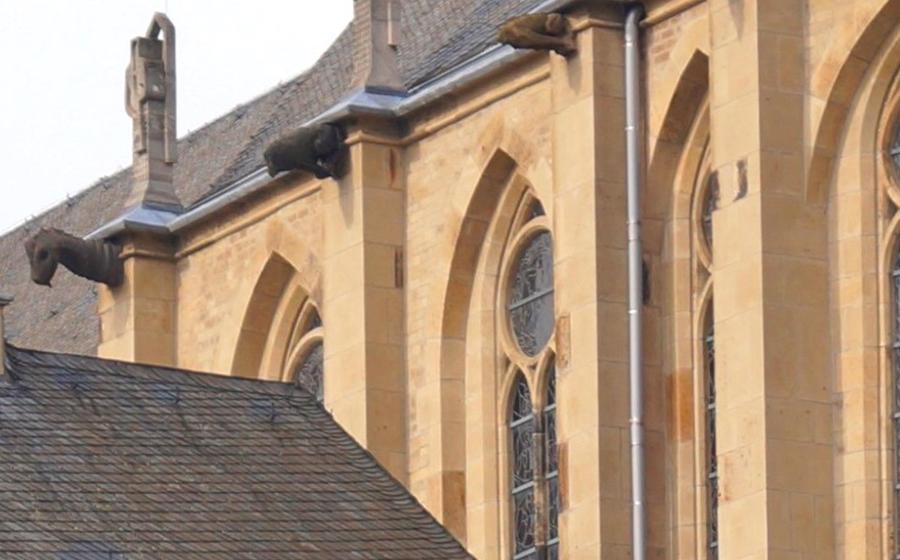
Gladbach Abbey
- Gladbach Abbey: A Benedictine Monastery
- Exploring the Abbey Grounds
- Witnessing Monastic Life
- Unveiling the Abbey's Art Collection
- Delving into the Abbey's History
- Walking the "Abtei-Rundweg" (Abbey Circuit)
- Attending Events at the Abbey
- Discovering Local Delicacies
- Shopping for Unique Souvenirs
- Connecting with Nature
- Visiting the Museum Abteiberg
- Attending Religious Services
- Exploring Mönchengladbach's Textile Heritage
- Insider Tip: Experience the Mönchengladbach Carnival
Gladbach Abbey: A Benedictine Monastery
Originally founded in the 10th century, Gladbach Abbey holds a prominent place in the annals of Mönchengladbach. This Benedictine monastery, steeped in history and architectural grandeur, stands as a testament to the city's rich religious and cultural heritage. Its imposing facade, Gothic-style windows, and intricate carvings hint at the narratives that unfold within its walls.
Throughout the centuries, Gladbach Abbey has borne witness to the ebbs and flows of time. It has survived wars, fires, and periods of decline, yet it has consistently remained a beacon of faith and community in Mönchengladbach. As one steps through the abbey's gates, a sense of tranquility envelops, inviting visitors to explore the architectural details and historical significance that make this monastery truly remarkable.
The abbey church, with its towering spires and ornate interior, is a testament to the devotion and craftsmanship of past generations. The cloister, with its serene arcades and beautifully preserved gardens, provides a glimpse into the daily lives of the monks who once called this place home. The abbey's museum, housed in the former stables, offers a fascinating journey through the monastery's history, showcasing medieval artifacts, religious relics, and contemporary artworks.
Exploring the Abbey Grounds
The Gladbach Abbey complex is a treasure trove of historical, architectural, and spiritual wonders. At the heart of the abbey lies the Abbey Church, a stunning example of Romanesque architecture. The church boasts intricate stone carvings, stained glass windows, and a magnificent altar. Visitors can marvel at the vaulted ceilings, adorned with frescoes depicting scenes from the Bible.
Adjacent to the church is the Cloister, a peaceful oasis surrounded by arched walkways and lush gardens. The cloister once served as a place of contemplation and meditation for the Benedictine monks. Today, it offers visitors a tranquil retreat from the hustle and bustle of city life.
The Museum at Gladbach Abbey houses a remarkable collection of artifacts that shed light on the abbey's rich history and religious significance. Visitors can explore exhibits showcasing medieval manuscripts, liturgical objects, and artwork that adorned the abbey over the centuries.
The Gardens of Gladbach Abbey are a horticultural masterpiece, showcasing a diverse array of plants and flowers. The gardens were meticulously designed to provide a serene and contemplative environment for the monks. Today, visitors can stroll through the gardens, admiring the colorful blooms and enjoying the fresh air.
Witnessing Monastic Life
The Benedictine Way of Life
At Gladbach Abbey, the Benedictines follow the Rule of Saint Benedict, a set of guidelines that emphasize prayer, work, and community living. The monks rise early for morning prayers, followed by a day filled with work and study. They maintain a strict schedule of daily rituals, including communal meals, prayer services, and periods of silence. By embracing this way of life, the Benedictines strive to create a harmonious balance between the spiritual and the practical.
Daily Rituals
The daily routine at Gladbach Abbey is centered around prayer and work. The monks gather for morning prayers at 6:30 am, followed by breakfast and a period of work. They then come together for midday prayers and a communal lunch, after which they engage in various tasks, such as gardening, carpentry, or bookbinding. In the afternoon, they have another period of prayer, followed by a short break for tea. The evening concludes with dinner and night prayers, before the monks retire to their cells for a well-deserved rest.
Special Events
Throughout the year, Gladbach Abbey hosts a number of special events that invite visitors to experience the Benedictine way of life. During Holy Week, for example, the abbey holds special liturgies and processions, offering a glimpse into the spiritual traditions of the monks. There are also annual events such as the Abbey Festival, where visitors can enjoy live music, food stalls, and guided tours of the abbey grounds.
Volunteer Opportunities
For those seeking a deeper immersion into monastic life, Gladbach Abbey offers volunteer opportunities. Visitors can join the monks for daily prayers, assist with maintenance work, or participate in gardening and cooking activities. Volunteering at the abbey provides a unique opportunity to learn about the Benedictine way of life firsthand and to contribute to the community.
Unveiling the Abbey's Art Collection
The Gladbach Abbey boasts an impressive art collection that spans various eras and styles, offering visitors a glimpse into the artistic heritage of the region. Among the highlights of the collection are medieval treasures, including intricate goldsmith work, religious sculptures, and illuminated manuscripts that showcase the exquisite craftsmanship of the period.
The abbey also houses a collection of Baroque masterpieces, demonstrating the influence of the Baroque era on the region's art scene. Visitors can admire grand altarpieces, opulent paintings, and delicate sculptures that embody the grandeur and theatricality of the Baroque style.
In addition to these historical works, the abbey also features a collection of contemporary art, showcasing the creativity and innovation of modern artists. This collection includes paintings, sculptures, installations, and mixed media pieces that reflect the diverse artistic expressions of the 20th and 21st centuries.
To enhance visitors' appreciation of the art collection, guided tours are available, providing insights into the historical and artistic significance of the works on display. These tours offer a deeper understanding of the abbey's rich artistic heritage and the stories behind the masterpieces that grace its walls.
Delving into the Abbey's History
The history of Gladbach Abbey is a rich and storied one, dating back to its foundation in the 10th century. It was built on the site of a Roman villa and quickly became a center of religious and cultural life in the region. Over the centuries, the abbey underwent several expansions and renovations, reflecting the changing needs of the monastic community and the architectural styles of the time.
During the Protestant Reformation, the abbey was briefly secularized, but it was later returned to the Catholic Church. The abbey survived the Thirty Years' War relatively unscathed, but it was badly damaged during the Napoleonic Wars. In the 19th century, the abbey was secularized once again and its lands were sold off. The abbey buildings were used for various purposes, including a hospital and a school, before being returned to the Catholic Church in 192
The abbey was heavily damaged during World War II, but it was subsequently rebuilt and restored. Today, the abbey is a thriving religious and cultural center, home to a community of Benedictine monks and a variety of events and activities.
Walking the "Abtei-Rundweg" (Abbey Circuit)
The Abbey Circuit is a must for nature lovers and history buffs. This picturesque trail winds its way through the Abbey grounds, offering stunning views and fascinating insights into the Abbey's past. The path is well-marked and accessible, making it suitable for visitors of all ages and abilities.
Along the way, you'll encounter various historical landmarks that tell the story of the Abbey's rich history. These include the Abbey's former mill and granary, as well as a series of chapels and Stations of the Cross. The trail also takes you through the Abbey's beautiful gardens, where you can admire the colorful flowers and tranquil ponds.
In addition to its historical and natural attractions, the Abbey Circuit also features a number of interactive stations. These stations provide information about the Abbey's history, architecture, and flora and fauna. There are also several rest areas along the path where you can take a break and enjoy the scenery.
Whether you're looking for a leisurely stroll or a more in-depth exploration of the Abbey's history, the Abbey Circuit is the perfect way to experience the beauty and tranquility of this historic site.
Attending Events at the Abbey
Gladbach Abbey's impressive acoustics and serene atmosphere make it an inspiring venue for various cultural events. Throughout the year, the abbey hosts a diverse program that includes concerts, exhibitions, workshops, and festivals.
Music lovers will be captivated by the abbey's regular concert series, which features performances by renowned musicians and ensembles from all over the world. From classical recitals to contemporary compositions, the abbey's concerts offer a unique musical experience in a historical setting.
Art enthusiasts can delve into the abbey's rich artistic heritage through its temporary exhibitions. These exhibitions showcase works by both emerging and established artists, encompassing a wide range of styles and genres. Guided tours provide visitors with insights into the artworks and the inspiration behind them.
Workshops and seminars at the abbey offer opportunities for personal growth and creativity. Participants can learn from experts in various fields, such as art, music, spirituality, and personal development. These workshops provide a unique blend of knowledge and inspiration, allowing participants to explore new interests and expand their horizons.
The abbey's annual festivals are a highlight of the cultural calendar, attracting visitors from near and far. These festivals celebrate the abbey's history, traditions, and diverse cultural influences. From medieval markets to contemporary music festivals, there's something for everyone to enjoy.
Whether you're a music lover, an art enthusiast, or simply seeking a unique and inspiring experience, Gladbach Abbey offers a diverse range of events that cater to all interests. Be sure to check the abbey's website or contact the abbey directly for information on upcoming events.
Discovering Local Delicacies
Mönchengladbach's culinary scene is a delightful blend of traditional German fare and modern culinary innovations. While in Gladbach Abbey, take advantage of the opportunity to sample some of the region's specialties.
-
Monastic Breweries: Mönchengladbach has a long history of brewing, and the city is home to several monastic breweries that have been producing beer for centuries. Visit one of these breweries to sample their fresh, handcrafted brews and learn about the brewing process.
-
Traditional Food Markets: Immerse yourself in the local culture by visiting one of Mönchengladbach's traditional food markets. Here, you'll find an array of fresh produce, artisanal cheeses, cured meats, and other local delicacies. Sample the regional specialties and enjoy a picnic in the nearby Abbey gardens.
-
Specialty Restaurants: Mönchengladbach offers a diverse range of restaurants, from traditional German taverns to international cuisine. Indulge in hearty German dishes such as schnitzel, bratwurst, and sauerkraut. For a unique experience, try a restaurant specializing in Mönchengladbach's textile heritage, where you can savor dishes inspired by the city's textile industry.
-
Cooking Classes: Take your culinary adventure to the next level by participating in a cooking class. Learn to prepare traditional German dishes or discover the secrets of regional specialties. Many cooking classes are offered in Mönchengladbach, providing a fun and interactive way to immerse yourself in the local cuisine.
Shopping for Unique Souvenirs
When visiting Gladbach Abbey, don't miss the opportunity to take home a unique souvenir. The abbey gift shop offers a wide range of items, including handmade crafts created by local artisans, such as pottery, jewelry, and textiles. You can also find local produce, such as honey, jams, and cheese, made by the monks themselves or by local farmers. For those interested in the abbey's history and culture, there is a selection of books and art, including prints and reproductions of medieval manuscripts. And of course, there are plenty of abbey-themed gifts, such as postcards, magnets, and keychains, to remind you of your visit.
One of the most popular souvenirs from the abbey is the "Abteibräu," a beer brewed by the monks themselves. The beer is made using traditional methods and is available in a variety of styles, including a light lager, a dark lager, and a wheat beer. You can purchase bottles of Abteibräu at the abbey gift shop or enjoy a glass at the abbey's restaurant.
Another popular souvenir is the "Gladbacher Rose," a sweet treat made from almonds, sugar, and rose water. The roses are handmade by the nuns of the abbey and are available in a variety of colors and flavors. You can purchase Gladbacher Roses at the abbey gift shop or at local bakeries and confectioners.
Whether you're looking for a unique gift for yourself or a loved one, you're sure to find something special at Gladbach Abbey.
Connecting with Nature
Immerse yourself in the tranquil beauty of the Abbey's gardens, a haven of peace and tranquility. Stroll along winding paths, surrounded by lush greenery, colorful flowers, and the gentle sound of birdsong. Discover hidden corners, where sculptures and fountains add a touch of artistic charm to the natural surroundings.
Venture beyond the Abbey grounds to explore the nearby forests and parks, offering a refreshing escape into nature. Follow scenic walking and biking trails that wind through ancient woodlands, past shimmering lakes, and across picturesque meadows. Immerse yourself in the tranquility of the natural world, finding solace and inspiration amidst the wonders of creation.
For birdwatching enthusiasts, Mönchengladbach offers a rich diversity of avian species. Observe the graceful flight of migratory birds as they soar above the Abbey grounds, or spot rare and elusive species in the nearby nature reserves. With its serene atmosphere and abundant wildlife, Mönchengladbach is a paradise for nature lovers seeking rejuvenation and connection with the natural world.
Visiting the Museum Abteiberg
Nestled amidst the serene landscape of Mönchengladbach, the Museum Abteiberg stands as a testament to the city's rich artistic heritage. Housed within a striking modernist building, the museum boasts an impressive collection of modern and contemporary art that spans the 20th and 21st centuries.
Masterpieces and Rotating Exhibitions: The museum's collection encompasses a diverse range of artistic styles and movements, including Expressionism, Surrealism, Pop Art, and Conceptual Art. Visitors can marvel at masterpieces by renowned artists such as Pablo Picasso, Wassily Kandinsky, and Joseph Beuys, among others. The museum also features a program of rotating exhibitions, showcasing both established and emerging artists from around the world.
Educational Programs and Interactive Displays: The Museum Abteiberg is committed to fostering a vibrant and inclusive art community. It offers a variety of educational programs, workshops, and guided tours tailored to visitors of all ages and interests. Interactive displays and multimedia presentations further enhance the visitor experience, providing deeper insights into the artworks and the artistic process.
A Cultural Hub in Mönchengladbach: Beyond its exhibitions, the Museum Abteiberg serves as a cultural hub for Mönchengladbach, hosting a variety of events, lectures, and performances. Its rooftop terrace offers panoramic views of the city, making it a popular spot for relaxation and contemplation. The museum's café invites visitors to linger and savor delicious refreshments while immersing themselves in the creative atmosphere.
A Must-See for Art Enthusiasts: Whether you're an art aficionado or simply looking for a unique and inspiring experience, a visit to the Museum Abteiberg is an absolute must. Immerse yourself in the world of modern and contemporary art, discover new perspectives, and let your creativity soar.
Attending Religious Services
Gladbach Abbey is not only a historical monument and cultural center but also an active religious community. Visitors are welcome to attend religious services in the abbey church, which offers a serene and spiritual atmosphere. The Benedictine monks celebrate daily Mass, as well as special liturgies on Sundays and holy days. These services provide an opportunity to witness the monastic way of life and connect with the spiritual traditions of the abbey.
For those seeking spiritual guidance or counseling, the monks offer the sacrament of confession and are available for personal conversations. Visitors can also participate in retreats and workshops organized by the abbey, which provide a deeper immersion into the Benedictine spirituality and way of life. These programs offer a chance for personal reflection, prayer, and community building, allowing visitors to explore their own spiritual journey in a supportive and welcoming environment.
Exploring Mönchengladbach's Textile Heritage
Mönchengladbach's rich textile history is deeply interwoven with the city's identity. As a major center for textile production, it boasts a fascinating legacy that continues to shape its cultural landscape. Visitors can delve into this vibrant past by exploring the city's historical textile factories, museums, and workshops.
One of the must-see attractions is the Textilmuseum Mönchengladbach, housed in a former textile factory. This museum showcases a vast collection of textiles, machinery, and artifacts, providing insights into the city's textile industry from its early beginnings to the present day. Visitors can trace the evolution of textile production techniques, admire intricate fabrics, and learn about the challenges and triumphs faced by the industry over the centuries.
For a hands-on experience, visitors can participate in a guided tour of a historical textile factory. These tours offer a unique glimpse into the inner workings of the textile production process, from the sorting and spinning of fibers to the weaving and finishing of fabrics. Visitors can witness the intricate machinery in action and gain a deeper appreciation for the craftsmanship and skill involved in textile manufacturing.
Additionally, Mönchengladbach offers hands-on workshops where visitors can try their hand at various textile crafts. These workshops provide an opportunity to learn traditional techniques such as spinning, weaving, and dyeing, and to create their own unique textile creations.
Exploring Mönchengladbach's textile heritage is a journey through time, innovation, and creativity. Whether you're a history buff, a fashion enthusiast, or simply curious about the city's rich past, there's something for everyone to discover in this textile haven.
Insider Tip: Experience the Mönchengladbach Carnival
Immerse yourself in the exuberant spirit of the Mönchengladbach Carnival, a vibrant celebration rooted in centuries-old traditions. Starting on November 11th, the city transforms into a joyous realm of laughter, music, and colorful costumes. Witness the grand parade, a spectacle of creativity and humor, as floats adorned with satirical themes and caricatures weave through the cheering crowds. Don your most whimsical costume and let loose, joining the infectious energy that permeates the streets. Embrace the local tradition of "Altweiberfastnacht" (Old Women's Carnival), where women symbolically seize power, cutting off men's ties as a playful gesture of liberation. Revel in the lively atmosphere, sway to the rhythm of brass bands, and savor the camaraderie that defines this beloved festival. Whether you're a seasoned carnival enthusiast or a first-time visitor, the Mönchengladbach Carnival promises an unforgettable experience that will leave you with cherished memories and a newfound appreciation for the city's rich cultural heritage.
